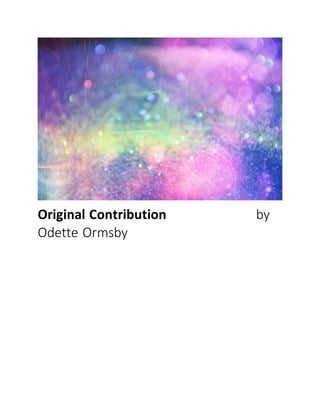
American College of Education Original Contribution
- 1. Original Contribution by Odette Ormsby
- 2. EIGHT ways to support linguistically diverse learners in mainstream classrooms Englishlanguage learnersface unique challenges.Theyare oftenfacedwithculture shockwhichcan have a negative impactontheireducational progress.Theymayface social isolationandlanguage barriers.The challengesof learninganew language andcontentmaterial atthe same time issurelya dauntingtaskthat can see manyfallingbehindacademically.Chamberlain,(2005) in Awang-Hashimet. al (2019) note that “students’inefficiencyinthe primarylanguage of the classroommaypose ahuge
- 3. challenge inthe processof teachingandlearningforboththe studentsandthe teacher”(p.122).Other Many mainstreamteachersfeel thattheyare underpreparedtoadequatelymeetthe needsof ELLs, especiallythose withveryLimitedEnglishProficiency(LEP).ItisclearthenthatELL studentsneed additional supportandconsideration.The followinginformationprovidesTEN waysinwhich mainstreamteacherscansupportyourELLs. 1. Examine your own biases As educators,we mustbe mindful of anybiasesthatwe mayhave.Our biasescanaffecthow we view individuals,groups,andeveninstitutions.Teachers’biasesmayleadtodiminishedexpectationsof studentsandaffecttheirengagementwithstudents.A consciousself-examinationisnecessarysince some of these biasesmaybe implicit,meaningthatbecause theyoperateinthe backgroundof how minds,we are unaware of how theyaffectourdealingswithothers(Dortin,2020). These biasesare oftenthe resultof “cognitive reasoningthatwasembeddedinourbrainsbefore we evenrealizedit (Cuellar,2017).Introspectionandmindfulnessare waysyoucan self-examinetoidentifythose biases. There isalso an abundance of websitesthatofferresources,includingbiastest,tohelpindividuals identifytheirbiases.Once we are able toidentifyourownbiases,we mustthenworktoaddressto diminishanynegativeeffectstheymayhave onthe teachingandlearningenvironment. 2. Getto know your ELLs Effective teacherscreate opportunitiestogetto know theirstudents.Gettingtoknow ourELLs allowsus to buildontheirstrengthsandisone of the firstand mostbasic stepswe can take to supportour ELLs. Informationsuchaswhere theyare fromcan offera glimpse intothe students’priorexperiences withschooling(Breiseth,2019). Teacherswouldalsobenefitfromlearningaboutsome cultural practices and traditionsof theirstudents,acceptable andtaboosocial behavior,andcommunicationpractices. Good sourcesof informationinclude:the studentsand/ortheirrelatives,school records,andhome language surveys(Breiseth,2019) The Culture CrossingGuide providesuseful informationoncultures aroundthe worldandcan be a quicksource of information. 3. Learn about theirculture Cultural awarenessisafundamental principle inteachingdiversegroupsof students.Byunderstanding culture,teacherscanempowertheirstudentsandhelptocreate anequitable learningenvironment.Itis alsoa goodideato familiarize yourselfwiththe cultural practicesof yourstudentsasthese canhave a direct impact on your classroom. For example, Muslims participate in a month of fasting called Ramadan. Studentswhoobserve Ramadanmayreceive accommodationthatincludesnotattendinglunchor recesswiththeirpeers.There are alsomanycultural contraststhat teachersneedtobe aware of so as not to cause offense.Forexample,inthe Vietnamese culture,itisnotappropriate totouch a person’s headas it isconsideredtobe the body’smostspiritual partwhile inthe Chinese culture beckoningor pointingwiththe index fingerisconsideredtobe “inthe bad form” (ProQuest&BYU, 2022). 4. Promote diversityinthe classroom/school The firststepin promotingdiversityinthe classroomistakingthe time togetto our studentsand creatinga welcomingenvironmentforall.Teacherscanalsopromote diversityintheirclassroomsby
- 4. usingdiverse teachingmethodstocreate lessonstoaccommodate the differentlearningpreferencesof students.Materialsusedinclassshouldreflectandpromote diversity.Teachersmustalsopractice cultural sensitivity.Currentresearchsupportsthe notionthatfamilyandcommunityengagementhasa positive effectonstudents’ learningoutcomes,inclusiveof theirgrades,social skills,andbehavior (McAlister,2013). Inaddition,researchhasdemonstratedthathavingaschool-communityconnection not onlybenefitsthe school butalsoimpactsstudents’ success(McAlister,2013). Create waysto celebrate diversityschool-wide andgetthe school- communityinvolvedinthe process!Invite diverse parentsto come infor classroomactivities! 5. Be informedon the language acquisitionprocess Whenmainstreamteachersdevelopanunderstandingof secondlanguageacquisition,itincreasestheir abilitytofacilitate the learningof culturallyandlinguisticallydiverse studentsintheirclassrooms(Hong, 2008). Teacherswhohave a knowledgeof the stagesthatstudentsgothroughare betterable to tailor theirinstructiontomeetthe needsof theirstudentsThe developmentstagesof language acquisition are: Pre-production:Thisstage isoftencharacterizedbya “silent-period”inwhichthere isminimal comprehension.Atthisstage,studentsknow about500 wordsinthe targetlanguage andbenefitgreatly if speechisaccompaniedbyvisuals,gestures,andfacial expressions(Dam, 2021). Early production:studentsrespondwithsimplewordsorshortphrasesinthe target language butstill relyheavilyonvisuals(Dam,2021 Speech emergence: studentsknowabout3,000 wordsand can produce simple sentences(Dam, 2012) Intermediate Fluency:In thisstage,studentshave developedavocabularyof about6,000 words.They have a highlevel of comprehensionasandlanguage ismore refined(ACE,2021). AdvancedFluency: At thisstage,studentshave developedsome specializedandcontentvocabularyand are able tofullyengage ingrade-level classroomactivitieswithoccasional support(Hong,2008).They can alsospeakEnglishcomparable tothat of theirnative-English-speakingpeers(Hong,2008). It isalso importanttorecognize thatthere isa differencebetweensocial andacademiclanguage. Sometimeseducatorsare puzzledwhenastudentidentifiedasanESL “seemsto speakperfectEnglish” whentheyare withtheirfriends.ResearcherJimCumminspostulatesthatsocial language knownas Basic InterpersonalCommunication(BICS) isacquiredmuchfaster(2-3years) thanacademiclanguage, alsocalledCognitive AcademicLanguage Proficiency(CALP)cantake between5-7yearsprograms (Street,B.& Hornberger,2008) Teachersneedtobe mindful nottomistake a students’proficiencyin interpersonalconversationwithproficiencyinacademiclanguage. 6. Use culturally responsive pedagogy Culturallyresponsive pedagogyisimportantinclassroomswithdiverselearners.Culturallyresponsive teachingchallengesteachersto “have ahighdegree of sociocultural consciousness,holdaffirmingviews of studentsof diverse backgrounds,seethemselvesasagentsof change,understandandembrace constructivistviewsof learningandteaching,andknow the studentsintheirclasses”(VillegasandLucas
- 5. (2002), inAngus& DE Oliveira(2012) (pp.27-28). Culturallyresponsive teachingnotonlyvaluesthe previousknowledgeandexperiencesthatstudentsbringtothe classroombutalsofindswaysto incorporate themintothe curriculum.Activitiessuchasactivatingstudents’priorknowledge,facilitating and validatingmultiple perspectivesinclass,andconnectingstudentslearningtoreal-life situationsare all strategiesforusingculturallyresponsive pedagogy.Vavrus(2008) notesthat a characteristicof the culturallyresponsiveteacherisone whoincorporatesknowledge learnedabouttheirstudents’culture and theircommunitiesintheirdailylessons.Finally,selectingtextsandmaterialsforclassroomuse requirescareful analysis.Thesematerialshave the powertoinfluence how studentsview themselves. Therefore, “careful examinationof ESLmaterialsisnecessaryinordertomaximize empoweringlearning experiencesandreduce negative andconfusinginfluencescreatedbybiasedcontent”(Ndura,2004). 7. Use research-basedclassroomstrategies Data is readilyavailable onresearch-basedpracticesthatmainstreamteacherscanuse tosupporttheir ELLs. Such strategiesincludecooperative learning,comprehensibleinput,vocabularyinstruction,and methodsdesignedtopromote literacydevelopment(Leavitt,2013). Noone methodor strategyfitsall so findingthe beststrategiesdependonthe specificneedsof yourstudents! 8. Use alternative assessments Why use alternative assessmentsforELLs?Well,alternative assessmentshelptopromote equitable access to education.Alternative assessmentsgivediverse studentsthe chance todemonstrate their learning.Since theseassessmentsare dynamic,ongoing,andclassroom-based,teachersare able to monitorthe progressof theirstudentsandadjusttheir lessonstosupportthe learningneedsof the students(Janisch,et.al.,2017). Some final thoughts… • Do not make assumptions;itisbettertoaskif unsure,orfindothersourcesto verifythe informationyouare seeking. • - Be mindful of the SilentPeriod.YourELLs needtime tolistenandwatchas othersspeakthe language before theyattemptit.Demonstrate yourpatienceusingcalmbodylanguage,anduse visual aidsandgestures. • Be mindful of cultural practicesandperspectives. • Rememberthere isadifference betweensocial languageandacademiclanguage.So,whenyou see yourELL studentinteractinginEnglishinsocial contexts,itdoesnotmeanthattheycan do the same withacademiclanguage. Thisblogwas completedinfulfillmentof the Capstone experience requirementthroughthe American College of Education,2022. References
- 6. Angus,R. & De Oliveira,L.(2012, December).DiversityinsecondaryEnglishclassrooms:Conceptions and enactments. English Teaching Practiceand Critique,11(4). https://files.eric.ed.gov/fulltext/EJ999749.pdf Awang-Hashim, R.,Kaur,A.& Valdez,N.P.(2019,June).Strategizinginclusivityinteachingdiverse learnersinhighereducation. Malaysian Journalof Learning and Instruction,16(1). https://files.eric.ed.gov/fulltext/EJ1219877.pdf Breisheth,L.(2019). Gettingto knowyourELLs: six stepsforsuccess. https://www.colorincolorado.org/article/getting-know-your-ells-six-steps-success Cuellar,N.G.(2017) Unconsciousbias:what isyours? Journalof TransculturalNursing.28(4) DOI: 10.1177/1043659617713566 Dam, L. (2021, March 19). Stagesof the NaturalApproach [Video].AmericanCollegeof Education Hong,Y. (2008, January) 61 Onteachingstrategiesinsecondlanguage acquisition. US-China Education Review,5(1). https://files.eric.ed.gov/fulltext/ED502535.pdf Janisch,C.,Liu,X.,& Akrof,A.(2007, Spring).Alternativeassessments:Opportunitiesandobstacles. The EducationalForum,71.https://files.eric.ed.gov/fulltext/EJ763213.pdf Leavitt,A.(2013). TeachingEnglishlanguage learnersinthe mainstreamclassroom:The methods teachersuse. TheResearcher,25(1), 79-93. McAlister,S.(2013). Why communityengagementmattersinschool turnaround.VUE Winter/Spring. https://files.eric.ed.gov/fulltext/EJ1046328.pdf Ndura,E. (2004). ESL and cultural bias:Ananalysisof elementarythroughhighschool textbooksinthe WesternUnitedStatesof America. Languageand CultureCurriculum,17 (2).p. 143- 153. http://jbox.gmu.edu/bitstream/handle/1920/2899/Ndura_ESL_and_cultural.pdf?sequence=1&isAllowe d=y ProQuestLLC & BrighamYoung University.(2022). Vietnam.Culturegrams,WorldEdition2022. Retrievedfrom http://guide.culturecrossing.net/. ProQuestLLC & BrighamYoung University.(2022). China.Culturegrams,WorldEdition2022. Retrieved fromhttp://guide.culturecrossing.net/. Street,B.& Hornberger,N.H.(Eds.).(2008). Encyclopediaof language andeducation,2ndedition, New York: SpringerScience + BusinessMedia,2.p.71-83 Vavrus,M. (2008). Culturallyresponsive teaching.21STCenturyeducation:A referencehandbook,.2,49. 57, https://www.researchgate.net/profile/MichaelVavrus/publication/326657963_Culturally_Responsive_T eaching/links/5b5b69930f7e9bc79a6937f4/Culturally-Responsive-Teaching.pdf Villacañas-de-Castro,L.S.(2018, January).Exploringcross-language transferof metaphorical skillswith bilingual Spanish/CatalanEFLlearners:A case study.DOI:10.17398/1988-8430.27.119